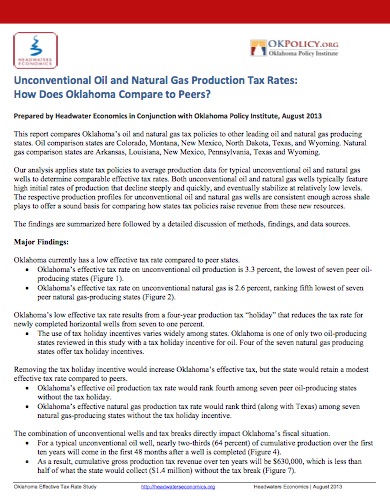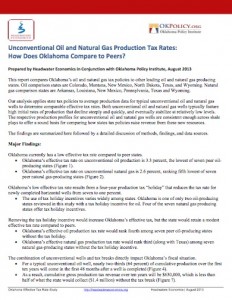
Click here to read "Unconventional Oil and Natural Gas Production Tax Rates: How Does Oklahoma Compare to Peers?," a study by the Oklahoma Policy Institute
Oklahoma Policy Institute


Click here to read "Unconventional Oil and Natural Gas Production Tax Rates: How Does Oklahoma Compare to Peers?," a study by the Oklahoma Policy Institute
Oklahoma Policy Institute

Oklahoma Policy Institute
Click here to Oklahoma Policy Institute's study, "Unconventional Oil and Natural Gas Production Tax Rates: How Does Oklahoma Compare to Peers?"
Oklahoma’s oil boom has led some to question the wisdom in giving hundreds of millions of dollars in tax breaks to a thriving industry.
As the state’s oilfields have boomed, so have tax breaks for oil and gas drilling. The Oklahoma Policy Institute has been critical of such state tax breaks, like those for horizontal drilling — an oil and gas extraction technique that was once experimental and has evolved to become an industry standard.
Oklahoma’s oil and gas industry supports the tax breaks, which they see as an investment in one of the state’s largest economic drivers.
The left-leaning think-tank on Aug. 26 released a study that shows if Oklahoma eliminated the incentives, its oil and gas taxes would still be modest compared to six of its oil-centric peer states.
Oklahoma levies a 7 percent gross production tax on oil and gas. But many oil and gas producers who drill horizontal wells only pay 1 percent for the first 48 months of production thanks to a tax incentive.
OK Policy tapped Headwaters Economics to study how Oklahoma’s effective tax rates on oil and gas would stack up to seven other states that do a lot of “unconventional” and horizontal drilling, both with and without Oklahoma’s tax breaks.
With the tax break, Oklahoma’s tax rate on oil is the lowest; for natural gas, Oklahoma is third lowest.
If the tax break were removed — or the current tax break was allowed to expire in 2015, as slated — Oklahoma slips to having the fourth-lowest tax rate for oil and natural gas.
Headwaters’ Mark Haggerty and OK Policy director David Blatt write in the report:
Removing the tax holiday incentive would increase Oklahoma’s effective tax, but the state would retain a modest effective tax rate compared to peers.
Here’s what the study shows:
| RANK | STATE | EFFECTIVE OIL TAX % | RANK | STATE | EFFECTIVE GAS TAX % | |
|---|---|---|---|---|---|---|
| 1 | OK | 3.3% | 1 | PA | 1.3% | |
| 2 | TX | 6.7% | 2 | LA | 1.9% | |
| 3 | CO | 6.8% | 3 | OK | 2.6% | |
| 4 | NM | 6.8% | 4 | AR | 4.1% | |
| 5 | MT | 7.5% | 5 | TX | 7.1% | |
| 6 | ND | 11.5% | 6 | NM | 9.1% | |
| 7 | WY | 11.7% | 7 | WY | 11.7% |
Source: Oklahoma Policy Institute
| RANK | STATE | EFFECTIVE OIL TAX % | RANK | STATE | EFFECTIVE GAS TAX % | |
|---|---|---|---|---|---|---|
| 1 | TX | 6.7% | 1 | PA | 1.3% | |
| 2 | CO | 6.8% | 2 | LA | 1.9% | |
| 3 | NM | 6.8% | 3 | AR | 4.1% | |
| 4 | OK | 7.1% | 4 | OK | 7.1% | |
| 5 | MT | 7.5% | 5 | TX | 7.1% | |
| 6 | ND | 11.5% | 6 | NM | 9.1% | |
| 7 | WY | 11.7% | 7 | WY | 11.7% |
Source: Oklahoma Policy Institute
Representatives of Oklahoma’s oil and gas industry say the state’s tax breaks for drilling help even out the highs and lows that come with a commodity-based business. What’s good for the oilfield is good for Oklahoma, basically.
But OK Policy’s Blatt says the tax breaks, which totaled $148 million in fiscal year 2013, aren’t worth the revenue losses. State Finance Secretary Preston Doerflinger has echoed this worry.
“We are dealing with severe budget pressures,” Blatt tells StateImpact. “We know that we haven’t been able to fund our schools adequately, and our corrections systems, child welfare and services for the developmentally disabled. So when you have a tax break in place that is costing the state such substantial revenue, it has real consequences.”
OK Policy’s report had another interesting finding: Oklahoma’s 48-month “holiday” covers the most productive time for horizontal wells.
In general, horizontally completed wells in oil and natural gas shale plays perform very similarly with high initial production, steep annual declines, and a flattening production curve after the first several years.
StateImpact Oklahoma is a partnership among Oklahoma’s public radio stations and produces journalism in the public interest, essential to an informed electorate. Help support informative, in-depth journalism with a donation online.